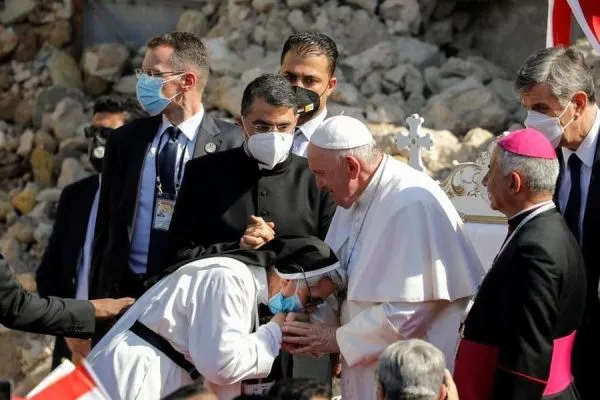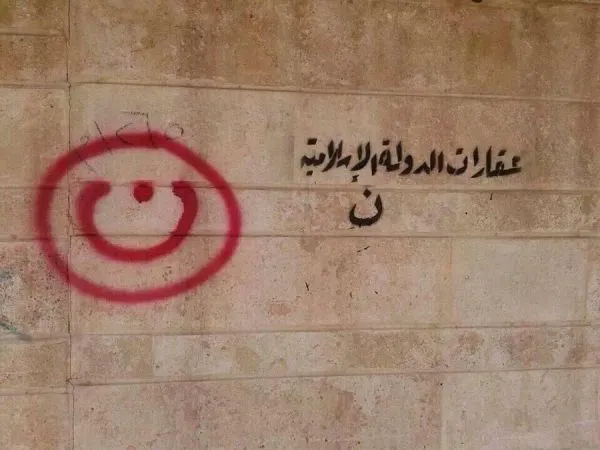10 years after Mosul’s destruction, will Christians come back?

 An unknown security guard stands at the entrance of a church destroyed during the fighting with ISIS in Mosul, Iraq. / Credit: CHRIS POOK/Shutterstock
An unknown security guard stands at the entrance of a church destroyed during the fighting with ISIS in Mosul, Iraq. / Credit: CHRIS POOK/Shutterstock ACI MENA, Jun 14, 2024 / 06:00 am (CNA).
The fall of Mosul, Iraq, to ISIS in 2014 wasn’t the beginning of the struggle for the city’s Christians. Killings, abductions, and threats from armed groups had plagued the community since the 2003 invasion by U.S. military. Clergy and laypeople alike bore the brunt of the violence, with bombings targeting churches as well.
The situation reached a peak when security forces crumbled, failing to protect Mosul, Iraq’s second-largest city and the heart of Nineveh province. ISIS seized control on June 10, 2014, plunging Mosul’s Christians into the darkest period of their recent history. Today, they grapple with rebuilding their lives while demanding accountability and a future built on equity and justice.
In the wake of clashes and bombings between security forces and ISIS, Mosul’s residents were left to fend for themselves. Witness Nahed Abdul Ahad, interviewed by ACI Mena, CNA’s Arabic-language news partner, described the complete absence of security forces.
“Many families fled the city, particularly Christians,” Abdul Ahad said. “They feared the worst, especially after widespread reports of killings and torture by terrorists. Others clung to the hope that this was just a temporary security lapse.”

ISIS’ brutality was swift and symbolic. On June 20, 2014, they destroyed the statue of “Our Lady of Tigris” atop the Al-Tahera Church as part of a campaign to “cleanse the place of polytheist features.” This act mirrored the destruction of other statues that had long been woven into the city’s character.
The terror escalated further on June 28, 2014, with the abduction of two religious sisters, Sister Atur and Sister Maskanta from the Daughters of Mary Chaldean Congregation, along with three children from the orphanage they ran. Thankfully, they were released unharmed on July 17. These events coincided with the declaration of the so-called “Islamic State in Iraq and Syria” and the establishment of the “Islamic Caliphate” under Caliph Abu Bakr al-Baghdadi.
The brutality of ISIS knew no bounds. After accusing Christian clergy of refusing a meeting, the group published a chilling document titled “Destiny” on July 18, 2014. Distributed by ISIS members, it was intended to be read aloud in mosques after Friday prayers.
This document presented an impossible choice for Mosul’s Christians: leave within 24 hours or face forced conversion to Islam, a hefty tax for non-Muslims (jizya), or death. Abdul Ahad, a witness to these horrific events, recounted the desperate exodus that followed.
“ISIS forbade us from taking anything,” Abdul Ahad said in an interview with ACI Mena. “Furniture, identification papers, money, gold — everything was confiscated. Many were forced to abandon their cars and walk, sometimes barefoot, toward Duhok and Erbil in Iraqi Kurdistan or the Nineveh Valley before it too fell to ISIS.”
The terror group marked Christian properties with the letter “N,” a reference to the Quranic term “Nasara” (Nazarenes), effectively claiming them for the Islamic State. Mosul, a city with a rich Christian heritage boasting 35 churches dating back 1,500 years, was emptied of its Christian inhabitants. For the first time in its history, the city stood virtually devoid of Christians, with only a handful too infirm or impoverished to leave.

Following Mosul’s liberation in 2017, a trickle of Christians began returning to the city. Bishop Mikail Najeeb, pastor of the Chaldean diocese in Mosul, described the return as “shy.”
In an interview with ACI Mena, he revealed that “according to diocesan statistics, no more than 100 families have returned, with only 35 being Chaldean.” Najeeb urged the government to support these families through reparations for lost property, a crucial step to encourage a more substantial return.
The dioceses in Mosul are slowly rebuilding their churches with their own resources, supplemented by support from Christian organizations worldwide. Churches like St. Thomas, the Church of the Annunciation, Al-Tahera for Syriac Catholics, St. Paul’s, and Our Lady of Help for Chaldeans are currently undergoing reconstruction.
This article was originally published by ACI Mena, CNA’s Arabic-language news partner, and has been translated and adapted by CNA.




